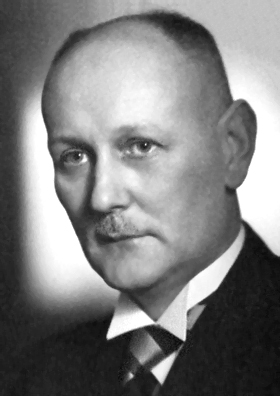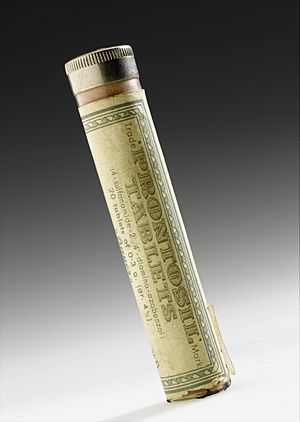Gerhard Domagk facts for kids
Quick facts for kids
Gerhard Domagk
|
|
|---|---|
 |
|
| Born |
Gerhard Johannes Paul Domagk
30 October 1895 Lagow, Brandenburg, Kingdom of Prussia, German Empire
(now Łagów, Świebodzin County, Lubusz Voivodeship, Poland) |
| Died | 24 April 1964 (aged 68) Burgberg, Baden-Württemberg, West Germany
|
| Nationality | German |
| Alma mater | University of Kiel |
| Known for | Discovery of sulfonamides such as Prontosil as antibiotics |
| Spouse(s) | Gertrud Strube |
| Children | One daughter and three sons |
| Awards | Cameron Prize for Therapeutics of the University of Edinburgh (1939) Nobel Prize in Medicine (1939) Paul Ehrlich and Ludwig Darmstaedter Prize (1956) Fellow of the Royal Society (1959) |
| Scientific career | |
| Fields | Bacteriology |
Gerhard Johannes Paul Domagk (German pronunciation: [ˈɡeːɐ̯haʁt ˈdoːmak]; 30 October 1895 – 24 April 1964) was a German scientist. He studied diseases and bacteria. He is famous for finding a special medicine called Prontosil. This was the first antibiotic available to buy. For this important discovery, he won the 1939 Nobel Prize in Medicine.
Domagk worked at a big company called IG Farben. His job was to test new chemicals to see if they could become medicines. He found a chemical that could fight against a type of bacteria called Streptococcus pyogenes. In 1935, his daughter, Hildegarde, got a serious infection from a needle. Doctors thought they might have to remove her arm. In a desperate attempt to save her, Domagk used his new medicine. It worked, and his daughter got better. This medicine was named Prontosil.
Domagk was chosen to receive the 1939 Nobel Prize. But the Nazi government in Germany stopped him from accepting it. After World War II and the fall of the Nazis, he was finally given the Nobel diploma in 1947.
Contents
About Gerhard Domagk
Gerhard Domagk was born in Lagow, which was part of the German Empire. His father was a school teacher. When he was young, his family moved to Sommerfeld. He finished his basic schooling there.
Early Life and War Service
In 1914, Domagk started studying medicine at the University of Kiel. But the First World War began, and he joined the German army as a volunteer. He saw terrible things during the war, especially how many soldiers died from infections. This experience made him want to find ways to fight bacteria. He promised himself that if he survived, he would work hard to solve this problem.
After the war ended in 1918, Domagk went back to university. He finished his medical degree in 1921. He then worked as an assistant at the University of Kiel.
Joining IG Farben
In 1925, Domagk married Gertrude Strube. They had three sons and one daughter.
In 1927, Domagk was offered a job at IG Farben. This was a large chemical company. He became the director of their Institute of Pathology and Bacteriology. Here, he continued to study how chemicals could be used as medicines. He especially focused on tuberculosis and chemotherapy. He stayed at IG Farben until he retired in 1961.
Domagk passed away from a heart attack in 1964.
Discoveries and Achievements
At IG Farben, Domagk's main job was to test new chemical dyes for their ability to kill germs. For a long time, scientists knew that some dyes had medical uses. For example, Paul Ehrlich used a blue dye to fight malaria in the late 1800s. Following these ideas, IG Farben worked on changing dyes to make new medicines.
Prontosil: The First Antibiotic
In the early 1930s, two scientists, Friedrich Mietzsch and Joseph Klarer, created a new dye. It had a special part called a sulphonamide group. They thought this part might be important for fighting infections. This new chemical was called KL730.
Finding its Power
In 1931, Domagk tested KL730 on mice that had bacterial infections. He found that it worked well against certain bacteria. He gave it the code D 4145. In one experiment, he infected 26 mice with Streptococcus pyogenes. He gave Prontosil to 12 of them. All 12 mice that received the medicine survived. The 14 mice that did not get the medicine all died.
In 1935, Domagk published his findings. At that time, there was no good medicine for streptococcal infections. Doctors often had to remove infected body parts.
A famous story shows how important Prontosil was. On December 4, 1935, Domagk's six-year-old daughter, Hildegarde, pricked herself with a needle. She got a very bad infection. Doctors thought they would have to cut off her arm to save her life. But Domagk gave her the new Prontosil medicine. Hildegarde recovered, and her arm was saved.
By 1935, the medicine was known as Prontosil. It quickly became the main antibiotic for many bacterial infections.
Later Discoveries
Prontosil and other sulfonamide medicines were amazing for their time. They saved many lives. Later, penicillin was discovered, which was even better and had fewer side effects.
However, Domagk's work on sulfonamides led to other important medicines. These included drugs to fight tuberculosis. This helped control the spread of tuberculosis after World War II. Even today, some medicines based on Prontosil are used for burns and urinary tract infections.
Zephirol: A Powerful Disinfectant
In 1932, Domagk also found another important chemical. He discovered that benzyldimethyldodecylammonium chloride could kill many germs. He published his findings in 1935, calling it Zephirol. He showed how Zephirol could be used on the skin to prevent infections, like before surgery. This led to Zephirol being sold as a common disinfectant. This discovery helped create a group of chemicals called quats. Quats are now used in many products, like cleaners and fabric softeners.
Cancer Research
From 1936, Domagk also focused on finding treatments for cancer. In 1956, he announced he had developed a promising anti-cancer drug called E-39. He showed that this compound could destroy cancer cells in animals. While this specific drug wasn't widely used, his research helped others study similar compounds for cancer treatment.
Nobel Prize Story
In 1939, Gerhard Domagk was chosen to receive the Nobel Prize in Medicine. This was for his discovery of Prontosil, the first widely available antibiotic. However, the Nazi government in Germany had a rule. They did not allow German citizens to accept Nobel Prizes. This rule was made after another German, Carl von Ossietzky, won the Nobel Peace Prize in 1935. The Nazi government was angry about this.
Domagk was told he had won the Nobel Prize. He tried to get permission from the German authorities to accept it. He even offered to donate money to the war effort if he could. But on November 17, 1939, he was arrested by the Gestapo, the secret police. He was held for a week. He was released only after he promised to refuse the award. The government officially announced that Domagk had "regretfully declined" the prize.
After World War II ended in 1945, the Nazi government fell. In 1947, the Nobel Foundation finally gave Domagk his Nobel medal and diploma. However, he could not receive the money that came with the prize because too much time had passed.
Awards and Honours
Besides the Nobel Prize, Domagk received many other awards and honours:
- In 1939, he received the Cameron Prize for Therapeutics of the University of Edinburgh.
- In 1941, he received awards from Italy and Hungary.
- He became a member of the German Academy of Sciences Leopoldina in 1942.
- In 1951, he attended the first Lindau Nobel Laureate Meeting.
- He received honours from Peru, Spain, Venezuela, and Japan.
- In 1955, he received the Grand Cross with Star of the Order of Merit of the Federal Republic of Germany.
- In 1959, he became a Foreign Member of the Royal Society in London.
Several places and institutions are named after him:
- Domagkpark, a public park in Munich.
- Domagkstraße, a road in Munich.
- The Krebsforschung Professor Dr. Gerhard Domagk (Cancer Research Professor Dr. Gerhard Domagk) foundation in Münster.
- The Gerhard-Domagk-Institut für Pathologie (Gerhard Domagk Institute of Pathology) at the University of Münster.
See also
 In Spanish: Gerhard Domagk para niños
In Spanish: Gerhard Domagk para niños


